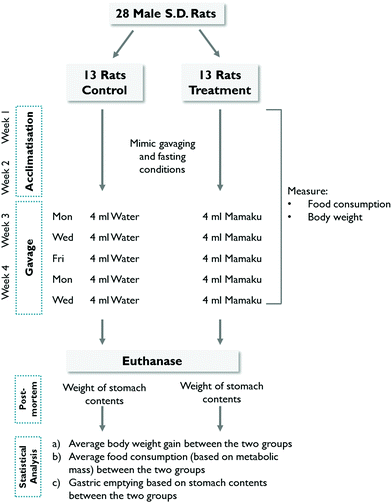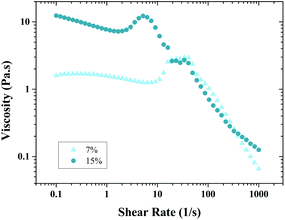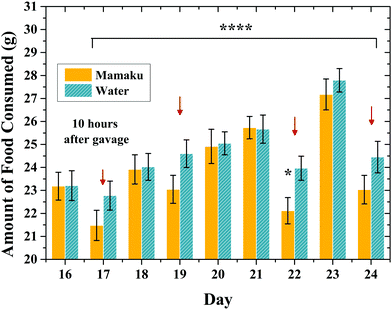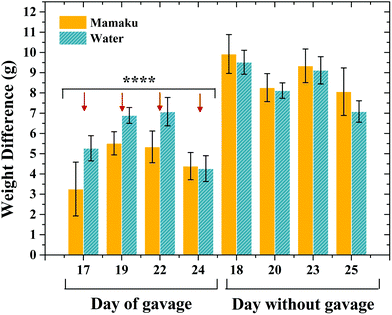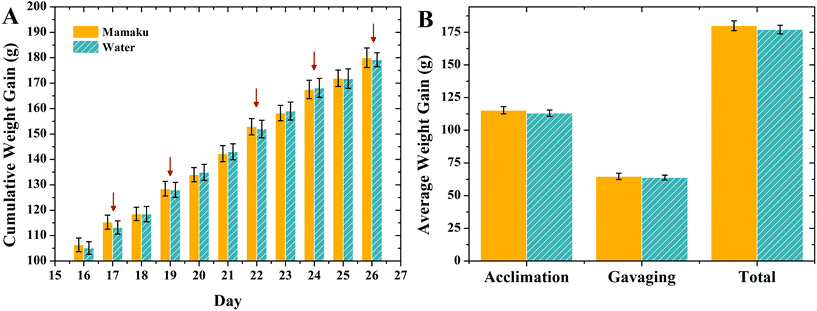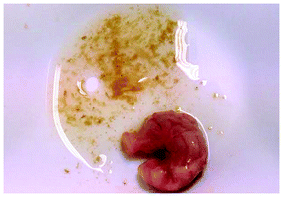The first of the viscoceuticals? A shear thickening gum induces gastric satiety in rats
M. S. M.
Wee
 ,
R. G.
Lentle
,
K. K. T.
Goh
and
L.
Matia-Merino
*
,
R. G.
Lentle
,
K. K. T.
Goh
and
L.
Matia-Merino
*
Massey Institute of Food Science and Technology, School of Food and Nutrition, Massey University, Palmerston North 4442, New Zealand. E-mail: l.matia-merino@massey.ac.nz; Tel: (+64) 06 3569099 x 83016
First published on 19th December 2016
Abstract
We examined the effect of gavage of 4 ml of a viscous shear-thickening polysaccharide solution (15% w/w) extracted from the fronds of the mamaku tree fern (Cythea medullaris) in reducing appetite and delaying gastric emptying in twenty six Sprague Dawley rats. After two weeks habituation to a pelleted chow, the rats were gavaged on alternate days with either the mamaku extract or with the same volume of deionised water for a total of five times over a period of two weeks. The body mass and food intake of each rat were determined daily and the weights of their stomach contents determined on euthanasia two hours after the final gavage. The rats gavaged with the mamaku gum consumed significantly lower quantities of chow on the day of gavage. The weights of the stomach contents of rats two hours after gavage with mamaku extract were significantly greater than those following gavage with water. The failure of the rats dosed with mamaku to lose body weight likely resulted from the overall adverse effect of gavage on food intake, the limited numbers of doses of the gum and the rebound hyperphagia on days when the rats were not gavaged. Together the results indicate that gavage with mamaku gum delayed gastric emptying with respect to that of rats dosed with water and supressed appetite for 12–24 hours after dosage.
1. Introduction
Recent work indicates that mamaku gum, a material obtained from the fronds of mamaku, the black tree fern (Cyathea medullaris), native to New Zealand that exhibits shear thickening,1–3 causes the direction of propagation of gastric antra corporal contractions to be disrupted4 which may cause gastric emptying to be compromised and engender gastric distension and satiety. Cooked mamaku fronds have long been eaten by Māori people5 and we can find no reports of any toxic effects. Hence it seems likely that the effects on motility resulted from changes in the pattern of stimulation mechanoreceptors due to the atypical rheology of the gum i.e. its shear thickening characteristics, which differs from the shear thinning behaviour of normal digesta.6The component of the gum that is thought to be responsible for shear thickening is a non-starch polysaccharide that comprises 11% (w/w) of the freeze dried frond sap and consists of a glucuronomannan backbone (methylesterified 4-GlcpA with 2,3- and 2,3,4-linked Manp) bearing side-chains of galactose, arabinose and non-methyl-esterified glucuronic acid, along with other simple sugars at the O-3 and O-4 of the mannose residues. The level of shear-thickening that this material exhibits appears to depend upon the ionic strength and cation type of the solution in which it is dissolved.7,8 Hence it may be possible to facilitate the development of shear thickening within the stomach by suitable adjustment of these constituents.
Gastric distension, either after the consumption of a meal or following a delay in gastric emptying,9,10 can induce a change in the pattern of its contraction11 gastric satiety10,12,13 and gastric emptying.14 The bulk of gastric emptying results from alteration in the tone of the proximal end of the stomach i.e. the fundus and is facilitated by antral contraction waves which promote flow towards the distal end of the stomach i.e. the pylorus, by minimising the pressure gradient immediately distal to the fundus. There is a brief opening of the pylorus as the antral contraction wave approaches allowing fluid gastric contents to be pushed through the pyloric sphincter into the duodenum. Fundal tone is adjusted via the vagus nerve15 by feedback loops based on myogenic and neural mechanoreceptors.16 The contractile activity of the body and antrum may similarly be modulated by mechanoreceptors.17,18
The concept of altering the rheological characteristics of the contents of the stomach has been explored hitherto.19 However the strategy relied on intragastric gelation in the acid environment of the stomach rather than the effect of a shear thickening agent.
The current work, explores the effects of direct gavage of the shear thickening agent mamaku gum into the stomach of adult Sprague Dawley rats on gastric emptying, food consumption and weight loss with a view to developing a non-pharmacological agent that induces gastric satiety from its component viscogenic polysaccharides.
2. Materials and methods
2.1 Mamaku solution
The method of extraction of mamaku gum from the mamaku tree fronds and its composition has been detailed in other publications.20 Briefly, the chopped fronds are extracted in an equal volume of deionised water (50 °C) for 15 min and compressed by hand using a cheese cloth to express the contained sap which is subsequently freeze dried. The freeze-dried mamaku gum extract was hydrated overnight in distilled water to a concentration of 15.0% w/w. The solution was subsequently sterilised by heating at 100 °C for approximately 3 minutes, and allowed to cool to room temperature (∼20 °C). The caloric content of the 15% w/w solution of mamaku gum that was used in this study was 0.36 kcal g−1 based on bomb calorimetry. It is noteworthy that this method of analysis is likely to overestimate digestible energy since little of the non-starch polysaccharide component is likely to undergo digestion.21 Hence digestible energy content of dietary fibre, typically is around 2 kcal g−1.2.2 Rheological measurements
The rheological characteristics of the hydrated mamaku gum prepared for the experiment were determined in a Paar Physica rheometer MCR 301 (Anton-Paar, Graz, Austria) in controlled shear rate (CSR) mode at 37 °C with the double gap (DG 26-7 and C-PTD 200) geometry with a Peltier temperature control to ensure that the material exhibited similar shear thickening characteristics to those previously.1,4 Data points were recorded using a log-ramp profile at time intervals of 30 seconds (initial) to 2 seconds (final).2.3 Animals and experimental design
The experimental protocol was approved by the Massey University Animal Ethics Committee (Palmerston North, New Zealand; Protocol No.: 14/21).Twenty-six 4 week old; male Sprague Dawley rats were reared in the Small Animal Production Unit of Massey University in Palmerston North, New Zealand. Each was housed individually in a wire-bottom cage and maintained at a temperature of 22 ± 1 °C with a 17/7 hour light–dark cycle (lights off at 1200–1900). The rats were maintained before and during the experiment on a pelleted chow with a total energy content on bomb calorimetry of 4 kcal g−1 formulated on a basis of ANI93M. The rats were acclimated on this chow for 14 days prior to commencement of the experiment. The chow was removed from the cages at 1900 each evening, so that the rats fasted for 13 hours prior to gavage the next morning. This procedure was carried out daily throughout the experiment including the acclimation period so that any effects of the limitation of food on the rate of food intake were well established. The rats had ad libitum access to food and water for the remaining 11 non-fasting hours. A summary of the experimental design is shown in Fig. 1.
At the end of acclimation period, thirteen rats of 200 g body mass were randomly assigned to either the control or the treatment group.
It was necessary to gavage the mamaku gum directly into the stomachs of the rats in order to avoid the difficulties of, and possible choking with, the swallowing of a shear thickening agent. It should be noted that the concentration of mamaku gum used in this study (15% w/w) was lower that the concentration used in Lentle et al.'s4 study (17% w/w) due to the shear thickening induced difficulty in passing higher concentrations of gum through the narrow bore of the gavage needle. Gavage of both water and mamaku gum was completed slowly i.e. over 20 seconds to avoid the development of high pressure in the oesophagus or stomach.
The rats were gavaged in the morning, at the end of the fasting period and prior to feeding, in randomised order with either 4 ml of deionised water or 4 ml of 15.0% w/w mamaku solution by an experienced operator using a straight ball-ended stainless steel gavage needle (size 18 ga × 76 mm; Instech Solomon) attached to a 5 ml syringe. Gavaging was performed on alternate weekdays each animal being gavaged on alternate weekdays a total of 5 times over the two week period (Wed, Fri, Mon, Wed and Fri). The caloric content of the (four ml) dose of mamaku gum solution given on alternate days was minimal compared with that of pelleted chow.
The rats were weighed daily at 0730 hours as were any unconsumed chow and ullages. Any evaporative or deliquescent change in the weight of the rat chow during the period of feeding was determined by weighing a 200 g sample that had been placed alongside the cages at the start and at the end of the experimental period. Rat chow (200 g) was dried at 104 °C in a forced draft oven to determine dry matter content.
Each rat was euthanized two hours after the final (5th) gavage by intraperitoneal phenobarbitone. The stomach was then exposed by a midline ventral incision and excised by division of the distal oesophagus just below the diaphragm and the duodenum just distal to the pyloric sphincter and weighed. The stomach was then incised with a lengthwise cut and weighed again after the contents has been removed. The quantity of chyme remaining in the stomach two hours post-gavage was then determined by difference. The proximal and distal oesophagus and stomach were subsequently checked for oedema and petechial haemorrhage as required by the Massey University Animal Ethics Committee.
2.4 Statistical analyses
Statistical analyses were conducted in Minitab® and Systat®.The mean daily increases in body mass and the changes in body mass 24 h after gavage, in rats gavaged with mamaku gum were compared by repeated measures ANOVA with those in rats gavaged with deionised water. Similarly the mean quantities of food consumed 24 hours after gavage by rats gavaged with mamaku gum were compared by repeated measures ANOVA with those consumed by rats gavaged with deionised water. The mean overall weight gain of all animals during the two week period of acclimation was compared by one way ANOVA with that during the two week period of gavage. Finally the mass of stomach contents that remained two hours after rats had been gavaged with mamaku gum was compared by one way ANOVA with that remaining in rats that had been gavaged with water. A Lilliefors and a Levene's test were performed on each data set to ensure that it was normally distributed and that there was equality of variance between the various treatment groups.
3. Results
3.1 Rheology
The mamaku gum used in this experiment exhibited similar properties to those reported by Goh et al.,1 notably, shear thickening in the range between 1 and 10 s−1 (Fig. 2) at 15% w/w mamaku with the apparent viscosity increasing from 7 Pa s at shear rate of 1 s−1 to approximately 12 Pa s at a shear rate of 6 s−1. The shear-thickening region steadily shifts to higher shear rates with decreasing mamaku concentration, with the shear-thickening occurring between 10–100 s−1 with approximately one-fold dilution (7% w/w mamaku). The dilution of mamaku with physiological fluids is expected to be much lower than this, therefore the effect of dilution was assumed to be negligible with regards to the shear thickening properties.3.2 Food consumption
The dry matter content of the rat chow was 90.2%. The change in weight of the 200 g sample of rat chow over 24 h was <0.1 g and thus was negligible compared with the amount consumed. Hence the results are expressed in grams of chow rather than grams of dry matter.All rats ate significantly less chow on the day that they were gavaged (days 17, 19, 22, 24) than on days when they were not (df 1, 27, F = 86.2, p < 0.0005) (Fig. 3). The rats that had been gavaged with mamaku ate significantly less chow on repeated measures ANOVA in the subsequent 24 hours (df 1, 23; F = 5.6; p < 0.05) than did the rats that had been gavaged with deionised water. Hence, whilst intake was reduced in all rats for 24 hours following gavage, the rats that had been gavaged with mamaku consumed significantly less chow than the rats gavaged with distilled water.
3.3 Body mass
3.4 Gastric emptying
The weights of the contents of the stomach two hours after gavaging with 4 ml of mamaku gum (1.013 ± 0.083 g) were significantly greater on ANOVA (df, 1, 22; F = 21.6; p < 0.005) than the weight of the contents of those gavaged with water (0.549 ± 0.046 g). The contents of the stomachs of rats dosed with the mamaku gum (upper left in Fig. 6) consisted largely of viscid masses of gum indicating that around a quarter of the gavaged mamaku gum had persisted in a largely undiluted state in the stomach for two hours post-gavage. It is noteworthy that there was a small residue of chow in the stomachs of rats that had been gavaged with water indicating that the procedure had not induced lasting satiety nor deterred them from ingesting food. It is also noteworthy that none of the stomachs or oesophagi bore any evidence of bruising (petchiae) or osdema.4. Discussion
The fact that the quantity of chow ingested was reduced for 24 hours after the rats had been gavaged with mamaku, compared with those gavaged with water, and the fact that this effect did not persist for the following day indicates that mamaku engendered readily reversible short-lived i.e. daylong satiety.It is unlikely that this arose from undue gastric distension on gavage22 as the volume used was lower than the functional volume of the stomach4 and gavage with the identical volume of water did not have a similar effect. Gavaging is known to induce stress in the rats.23 However the fact that significant quantities of food were found in the stomachs of rats that had been gavaged two hours previously with water indicates that this procedure did not have long term effects on food ingestion. Nevertheless, the finding that the mean weight gain was significantly lower over the total period that rats were gavaged with either mamaku gum or water than during the acclimation period indicates that the gavaging had a long term effect on weight gain and thus did stress the animals, as has been reported previously.24
However, the significantly lower mean weight gain of rats in the 24 hours following gavage with mamaku than those gavaged with water indicates that the effect of the mamaku on feeding persisted longer than the effect of gavage and was borne out by the finding that quantities of the gum remained in a viscid state within the stomach two hours after gavage, a period near the mean gastric residence time of the rat.25 This finding runs contrary to the hypothesis of Zhu, Hsu and Hollis26 who suggested that the postprandial satiety effects from viscogenic agents (other than those inducing shear thickening) such as guar gum do not last more than 3 hours. The rebounds in mean weight gain and in food consumption on the day following gavage are likely testament to the lack of gavage on that day. This, plus the ethical restriction in the number of doses of mamaku that could be given, along with the opportunity for the rats to compensate for day long anorexia by rebound hyperphagia on the day following gavage, likely accounts for the fact that the mean overall gain in weight gains at the end of the experiment were not significantly different between the group that was gavaged with mamaku gum and those that were gavaged with water. The finding does however suggest that the mamaku gum has no long term toxic effects.
The lack of overall reduction in the mean body weights of rats receiving mamaku gum should not be viewed as indicating the inability of mamaku gum to secure a long term reduction in body weight. Changes in body weight are generally evident only when treatment is applied daily27 for longer periods, generally more than eight weeks.28,29 Hence for example a significant difference between treatments in cumulative weight gain was only found in the fifth week in rats given dosed daily with viscous dietary supplements.28
The finding that the mean weights of the gastric contents two hours after gavage was significantly greater in rats that had received mamaku gum than in rats that had received water supports a hypothesis that the gum induced satiety by reducing gastric emptying. It could be argued that this effect resulted from the viscosity of the mamaku gum (7 Pa s at 1 s−1) rather than its shear thickening characteristics. Dosage with viscous solutions of guar gum, pectin and other shear thinning polysaccharides have been variously reported to delay gastric emptying, induce satiety and reduce food consumption.12,13,26,28,30–32 The viscosities of these various solutions ranged between 3.6 Pa s (0.8 s−1) and 16 Pa s which lie within the range exhibited by the 15% w/w mamaku gum that was used in this study,33 the apparent viscosity increasing from 7 Pa s at shear rate of 1 s−1 to approximately 12 Pa s at 6 s−1 over the shear rates that are encountered in the digestive tract i.e. between 1 to 10 s−1 (Fig. 2). However the effect of such agents appear to be borderline. Hence a number of other studies have shown that the administration of guar gum does not delay gastric emptying.34 Moreover, as discussed hitherto, it is generally considered that the effects of such agents are extremely short lived. Again previous work has shown that shear thinning agents such as guar gum do not influence the pattern of contractile behaviour. Hence while a 16.4% w/w solution of mamaku gum induced a change in the pattern of antral contractions in the ex vivo rat stomach a 1.5% w/w solution of guar gum did not. The finding with respect to guar gum is unsurprising as digesta generally exhibits similar shear thinning behaviour.4,6
It could also be argued that the proportion of the dose of mamaku gum that remained in the stomach was low and that some of the daylong effect may have resulted from the passage of the material through the more distal segments of the gut, notably the small intestine. Indeed the unusual shear-thickening and viscoelastic properties of the mamaku gum and their persistence despite any slow dilution are likely to influence the response of proprioreceptors and hence the pattern of contraction in any part of the gut. Thus the shear rates that are generated by any normal physiological contraction will engender a sharp increase in rotational and normal stresses within the gum.3 It is likely that the translation of these stresses into the adjacent mucosa and gut wall will cause atypical stimulation of the contained mechanoreceptors. It is also likely that the viscoelastic nature of the gum will impair the rapid dissipation of such stresses so the stimulus will be more prolonged.
In summary the results of the study indicate that the shear thickening properties of the non-starch polysaccharides in mamaku gum impair contractile function in the gut notably gastric emptying and induce a daylong reduction in food intake. However further work is required before mamaku gum can be used as an anorexiant in human subjects. Firstly in devising a safe means of delivery. Whilst the chopped and boiled fronds of the mamaku are eaten by Maori with no untoward effect, this is possible as the gum is consumed in situ within the plant vasculature. The consumption of the pure gum is complicated by the fact that its shear thickening properties may impede swallowing and cause choking. Hence it will be necessary, either to devise a method of encapsulation, or to change the ionic formulation of the water phase8 so as to temporarily ameliorate the shear thickening properties during swallowing.7 Again were the gum to be used as an anorexiant to combat obesity it may be useful to devise methods to further reduce the caloric content as in addition to the viscogenic polysaccharides, native freeze dried mamaku gum contains 10.3% starch and 49% simple sugars.1
Acknowledgements
We would like to thank Kim Wylie, Anne Broomfield, Corrin Hulls and Juliet Cayzer for their expertise in animal care and providing technical support throughout the experiment.References
- K. K. T. Goh, L. Matia-Merino, C. E. Hall, P. J. Moughan and H. Singh, Complex rheological properties of a water-soluble extract from the fronds of the black tree fern, Cyathea medullaris, Biomacromolecules, 2007, 8, 3414–3421 CrossRef CAS PubMed.
- A. Jaishankar, M. Wee, L. Matia-Merino, K. Goh and G. H. McKinley, Probing Hydrogen Bond Interactions in a Shear Thickening Polysaccharide using Nonlinear Shear and Extensional Rheology, Carbohydr. Polym., 2015, 123, 136–145 CrossRef CAS PubMed.
- M. S. M. Wee, L. Matia-Merino and K. K. T. Goh, Time- and shear history-dependence of the rheological properties of a water-soluble extract from the fronds of the black tree fern, Cyathea medullaris, J. Rheol., 2015, 59, 365–376 CrossRef.
- R. G. Lentle, P. W. M. Janssen, K. Goh, P. Chambers and C. Hulls, Quantification of the effects of the volume and viscosity of gastric contents on antral and fundic activity in the rat stomach maintained ex vivo, Dig. Dis. Sci., 2010, 55, 3349–3360 CrossRef PubMed.
- H. Leach, Fern consumption in Aotearoa and its Oceanic precedents, J. Polynesian Soc., 2003, 112, 141–155 Search PubMed.
- R. G. Lentle and P. W. M. Janssen, , Physical characteristics of digesta and their influence on flow and mixing in the mammalian intestine: a review, J. Comp. Physiol., B, 2008, 178, 673–690 CrossRef CAS PubMed.
- L. Matia-Merino, K. K. T. Goh and H. Singh, A natural shear-thickening water-soluble polymer from the fronds of the black tree fern, Cyathea medullaris: Influence of salt, pH and temperature, Carbohydr. Polym., 2012, 87, 131–138 CrossRef CAS.
- M. S. M. Wee, L. Matia-Merino and K. K. T. Goh, The cation-controlled and hydrogen bond-mediated shear-thickening behaviour of a tree-fern isolated polysaccharide, Carbohydr. Polym., 2015, 130, 57–68 CrossRef PubMed.
- G.-J. Wang, D. Tomasi, W. Backus, R. Wang, F. Telang, A. Geliebter, J. Korner, A. Bauman, J. S. Fowler, P. K. Thanos and N. D. Volkow, Gastric distention activates satiety circuitry in the human brain, Neuroimage, 2008, 39, 1824–1831 CrossRef PubMed.
- A. R. Mackie, H. Rafiee, P. Malcolm, L. Salt and G. van Aken, Specific food structures supress appetite through reduced gastric emptying rate, Am. J. Physiol.: Gastrointest. Liver Physiol., 2013, 304, G1038–G1043 CrossRef CAS PubMed.
- M. Orihata and S. K. Sarna, Nitric oxide mediates mechano- and chemoreceptor-activated intestinal feedback control of gastric emptying, Dig. Dis. Sci., 1996, 41, 1303–1309 CrossRef CAS PubMed.
- S. J. French and N. W. Read, Effect of guar gum on hunger and satiety after meals of differing fat content - relationship with gastric emptying, Am. J. Clin. Nutr., 1994, 59, 87–91 CAS.
- J. Tomlin, N. Brown, A. Ellis, A. Carlsson, C. Bogentoft and N. W. Read, The effect of liquid fiber on gastric emptying in the rat and humans and the distribution of small-intestinal contents in the rat, Gut, 1993, 34, 1177–1181 CrossRef CAS PubMed.
- K. Indireshkumar, J. G. Brasseur, H. Faas, G. S. Hebbard, P. Kunz, J. Dent, C. Feinle, M. J. Li, P. Boesiger, M. Fried and W. Schwizer, Relative contributions of “pressure pump” and “peristaltic pump” to gastric emptying, Am. J. Physiol.: Gastrointest. Liver Physiol., 2000, 278, G604–G616 CAS.
- J. Tack, in Physiology of the Gastrointestinal Tract, 4th edn, 2006, pp. 927–933 Search PubMed.
- T. L. Powley, X. Y. Wang, E. A. Fox, R. J. Phillips, L. W. C. Liu and J. D. Huizinga, Ultrastructural evidence for communication between intramuscular vagal mechanoreceptors and interstitial cells of Cajal in the rat fundus, Neurogastroenterol. Motil., 2008, 20, 69–79 CAS.
- H. Abrahamsson, Reflex Adrenergic Inhibition of Gastric Motility Elicited from the Gastric Antrum, Acta Physiol. Scand., 1974, 90, 14–24 CrossRef CAS PubMed.
- R. J. Phillips and T. L. Powley, Tension and stretch receptors in gastrointestinal smooth muscle: re-evaluating vagal mechanoreceptor electrophysiology, Brain Res. Rev., 2000, 34, 1–26 CrossRef CAS PubMed.
- H. P. F. Peters, R. J. Koppert, H. M. Boers, A. Strom, S. M. Melnikov, E. Haddeman, E. A. H. Schuring, D. J. Mela and S. A. Wiseman, Dose-Dependent Suppression of Hunger by a Specific Alginate in a Low-Viscosity Drink Formulation, Obesity, 2011, 19, 1171–1176 CrossRef CAS PubMed.
- M. S. M. Wee, L. Matia-Merino, S. M. Carnachan, I. M. Sims and K. K. T. Goh, Structure of a shear-thickening polysaccharide extracted from the New Zealand black tree fern, Cyathea medullaris, Int. J. Biol. Macromol., 2014, 70, 86–91 CrossRef CAS PubMed.
- C. Andrew, in Food Polysaccharides and Their Applications, CRC Press, 2006, pp. 629–663 Search PubMed.
- P. Enck, V. Merlin, J. F. Erckenbrecht and M. Wienbeck, Stress effects on gastrointestinal transit in the rat, Gut, 1989, 30, 455–459 CrossRef CAS PubMed.
- K. Okva, E. Tamoseviciute, A. Ciziute, P. Pokk, O. Ruksenas and T. Nevalainen, Refinements for intragastric gavage in rats, Scand. J. Lab. Anim. Sci., 2006, 33, 243–252 CAS.
- P. V. Turner, E. Vaughn, J. Sunohara-Neilson, J. Ovari and F. Leri, Oral Gavage in Rats: Animal Welfare Evaluation, J. Am. Assoc. Lab. Anim. Sci., 2012, 51, 25–30 CAS.
- C. Tuleu, C. Andrieux, P. Boy and J. C. Chaumeil, Gastrointestinal transit of pellets in rats: effect of size and density, Int. J. Pharm., 1999, 180, 123–131 CrossRef CAS PubMed.
- Y. Zhu, W. H. Hsu and J. H. Hollis, The Impact of Food Viscosity on Eating Rate, Subjective Appetite, Glycemic Response and Gastric Emptying Rate, PLoS One, 2013, 8(6) DOI:10.1371/journal.pone.0067482.
- R. Faipoux, D. Tome, A. Bensaid, C. Morens, E. Oriol, L. M. Bonnano and G. Fromentin, Yeast proteins enhance satiety in rats, J. Nutr., 2006, 136, 2350–2356 CAS.
- T. L. Davidson and S. E. Swithers, Food viscosity influences caloric intake compensation and body weight in rats, Obes. Res., 2005, 13, 537–544 CrossRef PubMed.
- A. Pranprawit, F. M. Wolber, J. A. Heyes, A. L. Molan and M. C. Kruger, Short-term and long-term effects of excessive consumption of saturated fats and/or sucrose on metabolic variables in Sprague Dawley rats: a pilot study, J. Sci. Food Agric., 2013, 93, 3191–3197 CrossRef CAS PubMed.
- N. Schroeder, L. F. Marquart and D. D. Gallaher, The Role of Viscosity and Fermentability of Dietary Fibers on Satiety- and Adiposity-Related Hormones in Rats, Nutrients, 2013, 5, 2093–2113 CrossRef CAS PubMed.
- C. M. Tiwary, J. A. Ward and B. A. Jackson, Effect of pectin on satiety in healthy US Army adults, J. Am. Coll. Nutr., 1997, 16, 423–428 CrossRef CAS PubMed.
- R. D. Mattes and D. Rothacker, Beverage viscosity is inversely related to postprandial hunger in humans, Physiol. Behav., 2001, 74, 551–557 CrossRef CAS PubMed.
- R. G. Lentle and P. W. M. Janssen, The Physical Processes of Digestion, Springer, 2011 Search PubMed.
- M. A. van Nieuwenhoven, E. M. Kovacs, R. J. M. Brummer, M. S. Westerterp-Plantenga and F. Brouns, The effect of different dosages of guar gum on gastric emptying and small intestinal transit of a consumed semisolid meal, J. Am. Coll. Nutr., 2001, 20, 87–91 CrossRef CAS PubMed.
| This journal is © The Royal Society of Chemistry 2017 |

